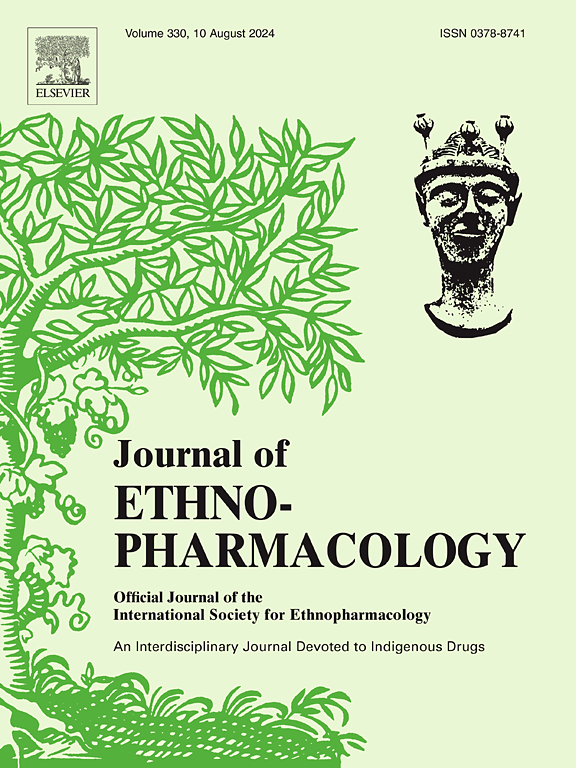Rosa roxburghii juice alleviates DEHP-induced reproductive system damage in male mice via the PI3K/AKT signaling pathway
IF 4.8
2区 医学
Q1 CHEMISTRY, MEDICINAL
引用次数: 0
Abstract
Ethnopharmacological relevance
Rosa roxburghii is an ethnic medicinal herb. Folk medicine collections have documented its nourishing and strengthen effects. It has been used to improve reproductive health, but scientific evidence supporting its efficacy and mechanisms remains limited.
Aim of this study
Endocrine-disrupting chemicals, such as di-(2-ethylhexyl) phthalate (DEHP), are known to impair male reproductive health. This study aims to investigate the protective effects of raw Rosa roxburghii juice (RRJ) on DEHP-induced reproductive toxicity in mice and elucidates its underlying mechanisms.
Materials and methods
Using a DEHP-induced murine model of reproductive damage, we evaluated the effects of RRJ on sperm quality, testicular histopathology, reproductive endocrine function, oxidative stress, inflammation, apoptosis, and DNA damage. Network pharmacology analysis was performed to identify the active components, targets, and mechanisms underlying the therapeutic effects of Rosa roxburghii.
Results
Our data demonstrated that RRJ significantly improved sperm quality, alleviated testicular atrophy, restored endocrine disorders, and mitigated oxidative stress, inflammation, and apoptosis in testicular tissues. Additionally, RRJ reduced testicular and sperm DNA damage, as evidenced by decreased γ-H2AX expression and DNA fragmentation index. Network pharmacology analysis identified quercetin, apigenin, luteolin, kaempferol, eriodictyol, and ellagic acid as the key bioactive compounds in RRJ, with the PI3K/AKT signaling pathway playing a crucial role in its therapeutic effects. Western blotting confirmed that RRJ reversed DEHP-induced suppression of the PI3K/AKT pathway.
Conclusions
This study demonstrates that RRJ protects against DEHP-induced reproductive toxicity through antioxidant, anti-inflammatory, and anti-apoptotic mechanisms, mediated in part by the PI3K/AKT signaling pathway. This work provides the first comprehensive evidence of the protective effects of Rosa roxburghii against male reproductive system damage and its underlying mechanisms.

刺梨汁通过PI3K/AKT信号通路减轻dehp诱导的雄性小鼠生殖系统损伤。
民族药理学相关性:刺梨是一种民族药材。民间医学典藏记载了其滋补强身的功效。它已被用于改善生殖健康,但支持其功效和机制的科学证据仍然有限。本研究目的:众所周知,干扰内分泌的化学物质,如邻苯二甲酸二(2-乙基己基)酯(DEHP),会损害男性生殖健康。本研究旨在探讨刺梨原汁(RRJ)对dehp诱导的小鼠生殖毒性的保护作用,并阐明其机制。材料和方法:采用dehp诱导的生殖损伤小鼠模型,研究RRJ对精子质量、睾丸组织病理学、生殖内分泌功能、氧化应激、炎症、细胞凋亡和DNA损伤的影响。通过网络药理学分析,确定了刺梨的有效成分、靶点和治疗作用的机制。结果:我们的数据表明,RRJ显著改善精子质量,缓解睾丸萎缩,恢复内分泌紊乱,减轻睾丸组织氧化应激、炎症和细胞凋亡。此外,RRJ降低了睾丸和精子的DNA损伤,这可以通过降低γ-H2AX表达和DNA片段化指数来证明。网络药理学分析发现槲皮素、芹菜素、木犀草素、山奈酚、戊二醇和鞣花酸是RRJ的关键生物活性化合物,PI3K/AKT信号通路在其治疗作用中起关键作用。Western blotting证实,RRJ逆转了dehp诱导的PI3K/AKT通路的抑制。结论:本研究表明,RRJ通过抗氧化、抗炎和抗凋亡机制保护dehp诱导的生殖毒性,部分由PI3K/AKT信号通路介导。本研究首次全面证明了刺梨对男性生殖系统损伤的保护作用及其潜在机制。
本文章由计算机程序翻译,如有差异,请以英文原文为准。
求助全文
约1分钟内获得全文
求助全文
来源期刊

Journal of ethnopharmacology
医学-全科医学与补充医学
CiteScore
10.30
自引率
5.60%
发文量
967
审稿时长
77 days
期刊介绍:
The Journal of Ethnopharmacology is dedicated to the exchange of information and understandings about people''s use of plants, fungi, animals, microorganisms and minerals and their biological and pharmacological effects based on the principles established through international conventions. Early people confronted with illness and disease, discovered a wealth of useful therapeutic agents in the plant and animal kingdoms. The empirical knowledge of these medicinal substances and their toxic potential was passed on by oral tradition and sometimes recorded in herbals and other texts on materia medica. Many valuable drugs of today (e.g., atropine, ephedrine, tubocurarine, digoxin, reserpine) came into use through the study of indigenous remedies. Chemists continue to use plant-derived drugs (e.g., morphine, taxol, physostigmine, quinidine, emetine) as prototypes in their attempts to develop more effective and less toxic medicinals.
 求助内容:
求助内容: 应助结果提醒方式:
应助结果提醒方式:


